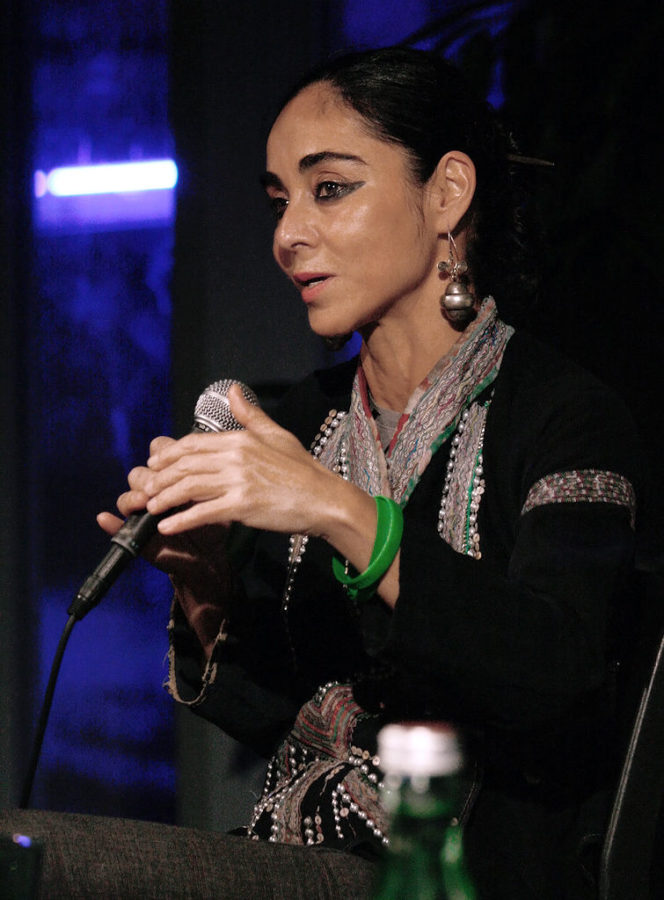Power and bravery through oppression shown in film screening
Shirin Neshat at an open discussion about her film Zanan bedun-e mardan “Women Without Men” during the Vienna International Film Festival 2009.
February 27, 2020
Shirin Neshat’s “Expressing the Inexpressible” was screened on Thursday afternoon at the Margaret Sloss Center for Women and Gender Equity to start off the celebration of 2020 Womxn’s History Month.
For the first event of the series to come this March, the Women’s Center, in cooperation with the Office of Multicultural Student Affairs, put on a film all about the power and bravery of women even in the face of oppression.
The 42-minute film highlighted the gender and cultural struggles of women in Muslim communities, such as her native country of Iran, with a series of short videos that Neshat created.
Some of the short installment films included “The Woman Moves,” “Soliloquy,” “Shadow Under the Web,” “Rapture,” “Turbulent” and “Fervor,” with inclusion of her photography series “The Women of Allah.”
The film included short fragments of her videos interspersed with Neshat’s narration about the story of her work and her own life as well.
Neshat has lived in the United States since the 1970s, as she stated in the film. She said she has assimilated to the culture in the United States somewhat, but she said she treasures her Iranian roots.
Neshat commented on her love for filmmaking and cinema, but said how she dislikes the passive viewing commonly associated with cinema. In her films, she tried to make it a point to engage her audience and make them a part of the experience. She said she likes to catch her viewers between the story and message she’s trying to get across and the dialogue used to tell it.
“The Women of Allah” was Neshat’s return to artistry. These include images of Muslim women with writing over them, giving the mute photos more of a voice to represent the emotional strength of the women shown in the photos. This project came from the eyes of an artist living on the outside, as she described herself, after coming back to Iran to complete this work. She had been absent for 10 years from her country at this time, so she too was trying to attempt to comprehend and analyze what had happened since she’d been gone.
Another of the included works, “Fervor,” tackled the taboo subject of sexuality in both the women and men of Muslim societies. A man was shown speaking to an audience of men and women, segregated, but side by side to show commonality between them, about how sexuality and desire should be suppressed instead of explored.
Neshat chose to not include subtitles for the man’s speech and instead present it as one watches an opera, using music and action to create the story rather than explicitly tell viewers what the story was. In the end, the man on the stage began to chant and everyone joined in with him. One woman did not, leaving the area instead in an act of defiance and rebellion to the oppression they face.
After the screening of the film, discussion questions were posed to get everyone involved in what they had just watched.
Helen Barton, senior in graphic design, commended Neshat on her attention to each element of her films.
“There is so much contrast,” Barton said in reference to “Turbulent,” Neshat’s film contrasting the gender differences in public performances. “Every detail is considered in that piece.”
“Turbulent” showed a man and a woman in performance halls. One had an audience, and one did not. Women were forbidden to view public performances, much less give performances themselves.
The man is shown singing a traditional Sufi song in a fairly stationary position, which would accompany spiritual dancing as a mediator between Earth and a higher plane. Women were not allowed to participate in such dances, and so the woman in the video is dancing along with her singing, her notes mixed with screaming, not letting herself be tied to traditional rules of how a woman should be or act.
That is the commonality that threads through Neshat’s films: the strength and power of repressed Muslim women despite their systematic oppression.

















